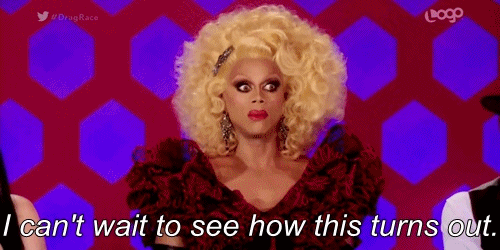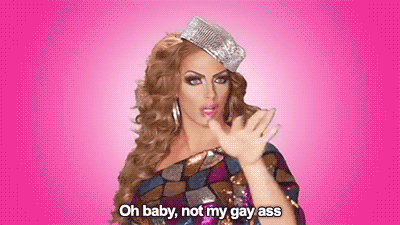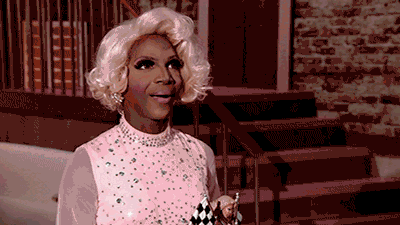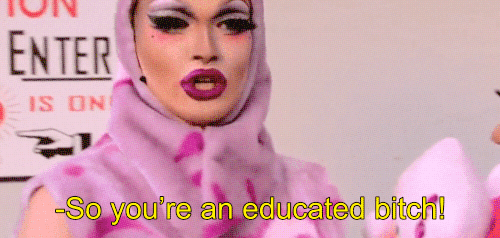The Good & the Bad following The Myth of Homosexual Man in a Neoliberal Era
For a few decades now, the homosexual man has been introduced in the realm of popular culture; whether his depictions work towards giving gay men a better life, or an even more complicated one, remains up for debate. Navigating through different perspectives on the subject matter, this essay shines a light on the positive and negative outcomes of such inclusions in mainstream media.
To start off, we will transpose Simone de Beauvoir’s myth of woman onto today’s mass media influence on gay men, which will lead us to the creation of normative identities and their respective others. Following this conceptualization, we will compare representations of masculinity and femininity within televised homosexuality, only then to conclude with broader ideas on the neoliberal implications of the modern communications industry.

Before I start this essay, it is important for me to disclose my standpoint. In regards to our subject matter, I consider myself to have been very much affected by homonormativity all through my life. In fact, although I currently identify as a non-binary individual, I have situated myself under the gay male label for a very long time, and most importantly, I am generally perceived as such to this day. Therefore, my thoughts and opinions may be influenced by lived experiences, which I hope adds flare to my arguments.
The Myth of Homosexual Man
First of all, let us analyze Simone de Beauvoir’s (2011) description of what she calls “the myth of woman” (p. 266), which I will later connect to our subject matter and translate into the myth of homosexual man. In fact, the author first sets the grounds with the dichotomy of myth and reality, attributing the quality of immutability to the first, which inherently acts to the detriment of the latter (Beauvoir, 2011). Given that the myth is considered to be an “absolute truth” and to represent “the Eternal Feminine”, the contradicting behavior of “real flesh-and-blood women” is said to be wrong, as these women are cast non-feminine (Beauvoir, 2011, p. 266). In other words, whenever man cannot adapt to woman’s real world subjective existence, the problem is not seen in him, but rather in her, as she does not fit the mystical bliss she is expected to embody; he therefore rejects the idea of an authentic human connection (Beauvoir, 2011). Not only does man dismiss the individuality of woman, but she herself is alienated and sees herself as incorrect and untrue when the myth is not a fit (Beauvoir, 2011).

Transposing this ideological system onto our topic, mainstream media takes on the role of man, and the homosexual man takes on the role of woman. Accordingly, gay men are under the command of a dominant culture, which encourages them to build their identities on the basis of a very specific vision of gayness, provided to them by the means of various forms of media. Thus, what Shugart (2003) calls the heterosexualization of gay men is a process through which main gay characters are shown to embody stereotypically heterosexual qualities, in contrast to secondary gay characters, whose illustration consists of conventionally homosexual traits. In an aim to reify the superiority of heterosexuality, homosexuality is presented as worthy of genuine love only when sufficiently comparable to its so-called opponent (Shugart, 2003). Concretely, representations of this viewpoint take place when gay male leads are depicted as traditionally masculine, through rough & tough behaviours, while their secondary counterparts express conventional femininity through obsession-like attitudes toward their appearance (Shugart, 2003). Of course, that is not to mention the White, muscular, and upper-middle class characteristics of most characters, regardless of their assigned roles (Brookey, 1996).
Correspondingly, what we can analyze as the main issue with media depictions is the quality of essence that is reached through the normalization of what is presented on screen, similarly to Judith Butler’s (1988) theory on gender performativity. Indeed, the author explains that the constant repetition of the same acts and mannerisms builds the perfect illusion of a substance that is both real and immutable. In that sense, a perfected image of what gay men are supposed to be is fed to millions, as it is consistently reified through popular TV shows and movies. Similarly to Beauvoir’s (2011) argumentation, gay men today are taught to wilfully adhere to the media representations of the myth of homosexual man, internalizing such constructions and building a community that glorifies masculinity and diminishes expressions of conventional femininity.

I am also tempted to add that although many characteristics attributed to main male characters are described as heteronormative, many of them have nothing to do, in my opinion, with being heterosexual. Indeed, a heterosexual individual can very possibly not be fit and White, and be rejected by the mainstream. Thereupon, to merge this multi-faceted construction into one single idea, which is heteronormativity, is an injustice to the variety of inequalities different people face on a daily basis.
Normative Identities & Forsaken Others
Digging right into our title, what we are pinpointing here is the lack of diversity in the depictions of homosexual men in mainstream outlets. Drawing a parallel with Hermann-Wilmarth and Ryan’s (2016) analysis of homonormativity in books meant for younger audiences, we can analyze apparent limitations in terms of the variety of representations of gay men. Indeed, the perpetual feature of normative identities results in the silencing of the ones that are seen as other (Hermann-Wilmarth & Ryan, 2016). Accordingly, this mechanism operates in even more discernable ways when linked to illustrations of race and class, which creates a movement of assimilation relatively to neoliberal ideals (Taylor, 2012).

From there, let us define the implications of homonormativity. As heterosexuality places itself atop of the social pyramid, its direct link with dominant culture generates repercussions on non-heterosexual identities (Esposito, 2009). Basically, gay men who are able to exemplify what is expected from them can be classified as conventional homosexuals, which gives them access to the realm of heterosexual privilege (Duggan, 2002). In other words, this elite cut of gays has to break its ties with any individual or group that does not correspond to the homonormative criteria, i.e. “the nonwhite and the nonmonogamous, the poor and the genderdeviant, the fat, the disabled, the unemployed, the infected, and a host of unmentionable others” (Love, 2009, p.10). Consequently, the new position of power these gays secure for themselves implies a dismissal of “what is queer about being queer” (Taylor, 2012, p. 148), and leaves the broader picture unaffected, as queerness remains under the label of undesirability (Murphy, Ruiz, & Serlin, 2008). Thus, a need for consumption and consequential alteration of the self is directly connected to the establishment of this apolitical gay culture (Duggan, 2002), and as a result, its virtual citizens locate themselves that much closer to the golden throne or social hierarchy, all while they pretend to do everything in their power to promote social forwardness and human advancement.
The Battle Between the Sissy and the Jock
Looking at specific portrayals of gay men in mainstream media can be very enlightening to the matter of homonormativity, especially when comparing different interpretations of similar content. Admittedly, transgressive representations in the framework of a TV show such as The Simpsons seem to be received relatively well by mixed audiences, a phenomenon that can be explained by a specific kind of hybridity: one that allows the viewer to identify with the cartoon characters, as human, while simultaneously maintaining a certain distance that is implied by the fantasy-like feature of the show.
First off, we can already see many gay-friendly representations within the show, even on a superficial level. Indeed, demonstrating the flexibility of heterosexuality, Homer’s character wilfully kisses his male secretary and claims It’s Raining Men as his favorite song (Padva, 2008). Furthermore, Smithers’ character is shown to have an obvious romantic attraction to his boss, Mr. Burns, and in the Homer’s Phobia episode, Homer asserts his unconditional love for his son, regardless of his sexual orientation (Padva, 2008). On a more intricate level, Padva (2008) claims that this particular TV show celebrates queer counter-culture, especially in the Homer’s Phobia episode, where the character of Marge is shown to become John’s fag-hag, as she sees in him all the marvelous qualities she desires in a man, i.e. qualities her husband seems to lack.

An interesting comparison can be drawn here, as the ideologies of two different authors turn out to be contradictory. In fact, on one hand, Shugart (2003) interprets the on-screen friendship between gay men and straight women to be reifying of hegemonic discourses. Accordingly, she refers to the portrayal of gay male leads as perfectly straight, except for the fact that they do not wish to sleep with women, meaning that they embody conventionally heterosexual features. On the other hand, Padva (2008) argues that the relationship between these two categories of people pushes the boundaries of acceptance as the term ‘fag-hag’ is reclaimed. As a matter of fact, she refers to Maddison’s (2000) work when she characterizes the gay man / straight woman kinship as one that is shared on the basis of a mutual oppression under hetero-patriarchy. Furthermore, the author explains, as she refers to White (1980), that while femininity used to be intrinsic to the so-called gay lifestyle, gay men are seen to celebrate, more and more, a hypermasculine aesthetic.
Nonetheless, Shugart and Padva agree on the anti-feminine attitudes that gay men are encouraged to adopt through homonormativity. Developing of Marge and John’s friendship, Padva (2008) demonstrates how The Simpsons’ depiction of John as a gay man is one that “enjoys his own stylishness, neatness and effeminacy, in contrast to many straight men and some sissy-phobic gay men” (Padva, 2008, p. 64). In other words, the character of John celebrates his non-hypermasculine individuality, rather than “mock male femininity, sissiness and stylishness” (Padva, 2008, p. 64).

Opening up on a different tangent, Padva (2008) argues that the promotion of diversity and forwardness in The Simpsons is not only conveyed by the inclusion of gay characters, but also by the recognition (manifested through the character of Homer) that heterosexuals as well as homosexuals are oppressed as a by-product of the stigmatization of sexual minorities. Indeed, although some men are more affected than others by “restricting hetero-masculine codes of visibility, behavior and sexual expression”, the pressure that is imposed here can be detrimental to all men (Padva, 2008, p. 66). Furthermore, I would argue that this kind of media exposure helps build a stronger bond between heterosexuals and non-heterosexuals, as it reaches heterosexual audiences from a point of view that is theirs.
Intrusion Into Pop Culture VS Reflection of Hegemony
Is it no shocker that the mainstream eye is obsessed with precisely defined categories, given that it is the most efficient way to market identities in a capitalist framework. From this undeniable reality, two subjective points of view are possible: while the first celebrates the well-anticipated entrance of the new-found category of homosexual man into the realm of dominant media, the second reverses it and interprets this one-dimensional pop cultural inclusion of gay men as an erasure of multi-faceted realities. Following this dichotomy, it all comes down to a matter of perception; a reflection of one’s ideologies.

In other words, in my perspective, many academic scholars state the obvious when they go on for pages and pages analyzing the various ways in which popular culture restates hegemonic conceptions. Although it is important to discuss such observations in order to enlighten the minds that are not aware of the implications of such depictions, I also believe that when we are presented with a blockbuster production, it is practically a given that conventional depictions will flood our sight. Accordingly, one must develop a mental field where hegemonic elements are the starting point, and in which some transgressive startegies can be deployed, as little they may be. In the end, what I mean to highlight is that there is a reason why a specific kind of content is popular: we could argue that mainstream media dictates culture, but it also appeals to people who were born into a certain lifestyle, and who enjoy the consistent reification of structures that provide them with a cycle of validation and self-worth. Additionally, as much as the people behind these productions can have unconventional ideologies, they have very strict budgets to comply with, and consequently cannot go off on a tangent where usual mainstream representations are totally dismissed.
In this specific framework, if a lead gay character is portrayed as flamboyantly feminine in a historical context where panache is not accepted as the norm, then it may not appeal to a wide audience, and it might just lose its intent altogether, which is to push the boundaries of the socially acceptable. It can therefore be seen as something that serves to introduce the mere idea of the embodiment of conventional femininity by male bodies to an audience that is not specifically open-minded. Inversely, it can have a very negative influence on the gay community, as we can easily see today when such a group puts on a pedestal any expression of conventional masculinity.

As a result, I am with the author when it comes to pinpointing what is wrong in media depictions in order to move forward, but I still like to give some credit to producers and writers who introduce transgressive content into popular culture, as minimal as it may be. Accordingly, if television content dating back to the 1990s were released today, it would probably not be worthy of praise in terms of its socially progressive substance, given that society has already gone further.
This leads me to contradict my previous argument: if we consider media depictions to be a direct reflection of the already established norm, it would imply that writers and producers are not using their power to push the boundaries of acceptance further, but are simply giving the public what they want, in a mirror-like manner. From this point of view, only radical pushes for change are effective, and the people involved in mainstream productions do have the duty to include more than a just a small variety of representations.
Concluding Thoughts: Blinded by our Own Realities
After delving into Simone de Beauvoir’s myth of woman and its translation onto modern depictions of gay men in the media, and after examining normative identities and their implications in terms of oppression, many subsequent ideas come to mind. As a matter of fact, hypermasculinity and hyperfemininity, as well as capitalist and neoliberalist by-products of mainstream media, can lead us to broader reflections, so let us get into it.

What I mainly take from this is that, in a neoliberal framework, mass culture and its productions are meant to appeal to the dominant class, as they are the ones who will sustain the market by the means of the capital they are ready to inject into the system. Therefore, mainstream television is often a reflection of the way dominant culture apprehends and progressively discovers marginalized groups, rather than being a platform where these groups are able to depict themselves in genuine ways, as this would result in a narrower audience, lesser profit, and most probably no popularity to sustain a capitalist cycle.
On one hand, we can see homonormativity as an illustration of individuals who initially belonged to a marginalized group, and who are then progressively and wrongfully sucked onto the other side, where normativity prevails. From this viewpoint, the fight for social change is at a loss, because it is deprived of its members to the benefit of hegemonic attitudes and discourses. On the other hand, asking for full and complete social change in the blink of an eye is mostly unrealistic, and so the slow inclusion of non-traditionally socially acceptable behaviors into the mainstream can be seen as a sign of progress.

Put it this way: if we consider that groups of people who are totally blinded by hegemony do not realize the wrongs of their lifestyles, for them to let one aspect of difference integrate their realm of celebration is a step forward. In that mindset, as time goes by, one category at a time can be added in what is glamorized and normalized. However, if we look the same situation from a perspective where it is all or nothing, the celebration of one strict new category encourages the people who identify with it to let go of other game-changing ideologies they might have, to the detriment of the overall movement of social justice.
Considering both positions, it is fair, in my opinion, to celebrate the addition of one of us in the dominant culture, while still keeping in mind that there is much more to achieve. If we decide to adopt an approach where we want people to consistently integrate game-changing attitudes in every sphere and every aspect of their everyday life, we will most probably end up alienating them from our fight and pushing them even further into the realm of the prevailing culture. However, many people who claim to be woke – and I use that term very loosely – will rightfully argue that it is not our duty to educate people who are indifferent to serious social issues, and that if they do not have the will to learn about different kinds of oppressions and the will to change their habits in an aim to help bring a positive change to social, political, and economic inequalities, then they are not worth our time. In my opinion, this debate ends up around whether we stand for peaceful and progressive means, or for a more radical and supposedly more efficient plan of attack on the long run. Accordingly, I believe both can work hand in hand, as one strategy cannot solve every aspect of the change we wish to see in the world.

Furthermore, looking at these kinds of situations in a very rigid and dichotomous eye only leads to divisiveness: the ones who are right, versus the ones who are wrong; the ones who are on our side, versus the ones who are on the other; the allies versus the enemies. Some might consider this binary to be quite effective in terms of moving forward at a faster pace, since it leaves behind anyone who does not fully agree on the terms of advancement, which is in the interest of immediate change. In opposition to this viewpoint are the ones who apprehend every situation on its own, injecting counter-hegemonic vibes into the mainstream, but simultaneously sustaining other elements of hegemony. Many people who adopt the second method like to think that they are engaging in fully conscious and informed decision-making, but whether we recognize it or not, our approach has a lot to do with the different levels of necessity we each uphold (Hartsock, 1983). Accordingly, it is only consequential for one to act radically in times of need, and inversely, opulence and luxury often results in lighthearted attitudes (Hartsock, 1983).

References
Beauvoir, S. D. (2011). Myth and Reality, Part III: MYTHS. The Second Sex, 266-274.
Brookey, R. A. (1996). A community like Philadelphia. Western Journal of Communication, 60, 40–56.
Butler, J. (1988). Performative Acts and Gender Constitution: An Essay in Phenomenology and Feminist Theory. Theatre Journal, 40(4), 519-531.
Duggan, L. (2002). The new homonormativity. In R. Castronovo & D. Nelson (Eds.), Materializing democracy: Toward a revitalized cultural politics (pp. 175–194). Durham, NC: Duke University Press.
Esposito, J. (2009). We’re here, we’re queer, but we’re just like heterosexuals: A cultural studies analysis of lesbian themed children’s books. Educational Foundations, 23(3–4), 61–78.
Hartsock, N. C. M. (1983). Money, Sex and Power: Toward a Feminist Historical Materialism. New York: Longman.
Hermann-Wilmarth, J., & Ryan, C. L. (2016). Queering chapter books with LGBT characters for young readers: Recognizing and complicating representations of homonormativity. Discourse: Studies in the Cultural Politics of Education, 37(6), 846-866.
Love, H. (2009). Feeling backward: Loss and the politics of queer history. Cambridge, MA: Harvard.
Murphy, K., Ruiz, J., & Serlin, D. (2008). Editors’ introduction. Radical History Review, 100, 1–9.
Padva, G. (2008). Educating The Simpsons: Teaching Queer Representations in Contemporary Visual Media. Journal of LGBT Youth, 5(3), 57-73.
Shugart, H. A. (2003). Reinventing privilege: The new (gay) man in contemporary popular media. Critical Studies in Media Communication, 20(1), 67-91.
Taylor, N. (2012). US children’s picture books and the homonormative subject. Journal of LGBT Youth, 9(2), 136–152.
White, E. (1980). The political vocabulary of homosexuality. In Michaels, L. & Ricks, C. (Eds.), The state of the language (pp. 235-246). Berkeley and Los Angeles: University of California Press.

Leave a comment